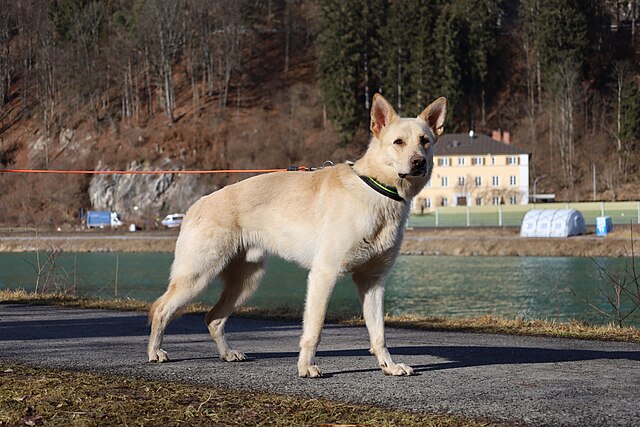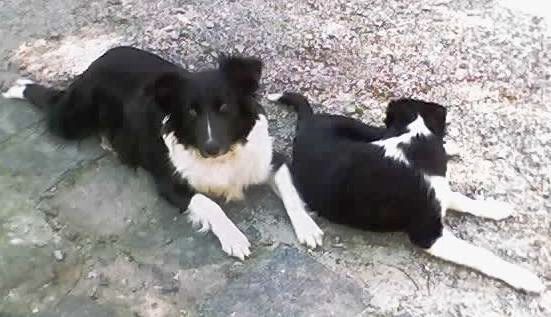The East European Shepherd (also known as the Vostochno Evropeiskaya Ovcharka or VEO for short) has Ukrainian and Russian roots, and was developed because breeders wanted a dog similar to the German Shepherd Dog but that could better withstand the colder temperatures of their region. In addition, they wanted a larger dog that could be used more effectively for military and police use. Development started in the early 1920’s when a number of German Shepherds were imported from Germany, and these dogs were bred with Central Asian Ovcharkas, East Siberian Laikas, and other local breeds. By the year 1950 the project was considered established enough that this new breed was given its name. Today the VEO is one of the most popular dogs of the former Soviet Union despite being quite rare in most parts of the world.
VEOs are incredibly intelligent and need to have a job to do in order to be happy. If not trained regularly they will find their own ways to pass the time which may result in destructive behaviors – one of the reasons they aren’t recommended for first time dog owners! They also must be raised and trained with a firm hand and strict rules or they may try to take advantage of a household. An experienced owner, however, will find that they are quick learners and can be taught just about anything. They are naturals at personal protection, guard work, border patrol and scent detection and are able to be taught so much more, with some individuals working in search and rescue or even as guide dogs. For the owner interested in dog sports, this would be an excellent candidate for agility or competition obedience.
The East European may look like a German Shepherd because of that breed’s heavy influence genetically but it is easier to tell the difference if they are standing next to each other. For one thing, the East European is a much bigger dog both in terms of height as well as general body weight. It is not uncommon for dogs of either sex to be over 100 pounds, with larger males frequently hitting 130 pounds or more! The head of the East European is usually much larger and more massive. The topline is also different – being fairly straight across with only a slight slope at the croup. The coat is short, very thick (thicker than the GSD) and rough to the touch with a well-developed undercoat. The three main color patterns are “wolf”, saddle-back or black/tan – with various color possibilities possible in each pattern.
When properly socialized, the VEO is excellent around strangers, albeit aloof. He is normally friendly yet calm when visiting with other people although does prefer to stay near, or keep “checking in” with his owner. It is common for the breed to choose one member of the family with whom he will form the strongest bond although he will love and protect the entire family. Unlike his German cousin, he doesn’t tend to be as clingy and is usually a calmer dog in general. Furthermore aggression and extreme shyness are very atypical when the dog is well-bred and socialized correctly. Do keep in mind that he may or may not get along with other dogs… many are not known for being particularly friendly with other pets, dogs included. He may also not be recommended for families with very small children because of his overbearing size.
The VEO is playful and very affectionate without being over-bearing, however if a threat arises from an aggressive stranger he is fearless in the face of danger! He is robust and resilient, alert, and has strong determination and deep protective instincts – all traits that made him well suited to his police and military duties. Like most working breeds, the VEO is active enough to need lots of regular exercise and is best suited to a home with a large fenced yard so he can run and stretch his legs regularly. He also needs structured exercise as well, such as regular jogging excursions or hikes with his owners. Living outside, even in cold temperatures, is possible for this breed as long as he is never neglected, however he is generally an excellent house dog.
Grooming is simple with the VEO. Simply brush once or twice a week and bathe when the dog is dirty. The coat does shed a little throughout the year, and twice a year the dog will blow coat which means a lot more shedding – this is the time to increase bath and brush sessions! Keep the ears clean to protect against ear infections as prick eared dogs can be more prone to getting dirt and grime in the ear canals. Otherwise upkeep is simple. Vet care is often less of an issue as well beyond regular maintenance visits, as the breed isn’t nearly as prone to the health conditions of the GSD. While hip dysplasia can be an issue, it crops up far less in this breed than his German counterpart.




